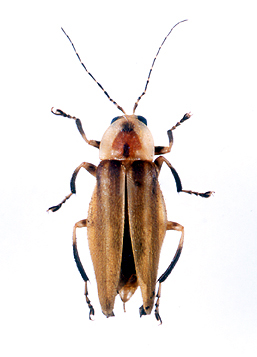Fireflies/Lightning Bugs
(Lampyridae)
Fireflies, also known as “lightning bugs”, are beetles belonging to the family Lampyridae. The use of the word “lamp” in their family name aptly illustrates the extraordinary characteristic that elevates fireflies to such a beloved position in the minds of humans. Anyone who has not witnessed a light show put on by fireflies has been deprived of one of the great wonders of the natural world. A firefly’s ability to create light stems from a controlled chemical reaction inside the abdomen of the firefly. Luciferin (a highly florescent substance) is combined with Luciferase (an enzyme), ATP (adenosine triphosphate) and oxygen in order to alter the Luciferin molecule so that its excited electrons produce florescent illumination. This “cold light” (containing no ultra violet rays) is used for communication. Fireflies generally flash at dusk and each species has it’s own way of communicating using these flashes of light. There are some diurnal species of fireflies but many of them have no ability to produce light. Fireflies in both the Old and New World use flashes of light from their abdomen for communication between the sexes. In the Old World, many fireflies aggregate in species-specific swarms of males that flash in synchronicity. In the New World, this is rare and the males generally fly around and flash over open areas, like fields or forest clearings, searching for a female. Females wait on the ground or on low vegetation and offer the proper response if they see a mate they like. A dialogue of flashes ensues which helps the male locate the female and make sure she's the same species as him. In the New World, this courtship rite has turned dangerous because fireflies in the genus Photuris have learned to imitate the flashes of other species. Using this ability, males of other species that are out seeking mates are lured in close and then captured and eaten. The behavior of Photuris is singular and most other species of fireflies either feed on plant fluids and pollens or live off stores of larval fat. The larvae of fireflies are also capable of producing light and are called glow worms. In contrast to the adults, most glow worms are predatory. Many species are associated with moist habitats and a few Asian species are fully aquatic. It has been surmised that glow worms produce light as a warning since many are poisonous. Adults of many species are also poisonous. In some species of fireflies the females are wingless and, in looking just like the larvae (except for their compound eyes), are also called glow worms. In North America, the Rocky Mountains serve as barrier which has kept most light-producing species in the east. For those who live in the western part of the U.S.A., light-producing species can be found if you look but they are limited in distribution due to moisture requirements. These western species are found in close association with moist forests and along the banks of rivers in the more arid regions. · We do not sell live fireflies for release at weddings.

